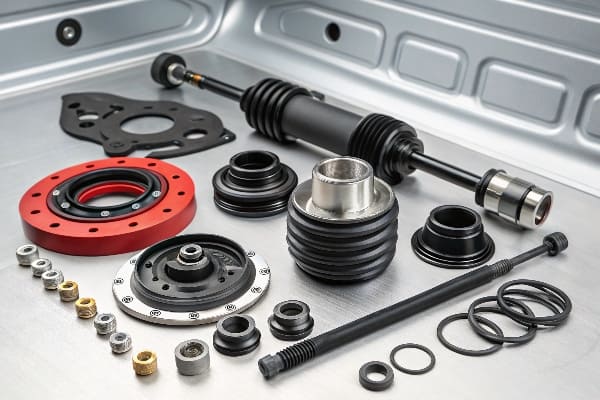Rubber is a crucial material in the automotive industry, used in various components for its durability, flexibility, and ability to withstand stress and weather conditions. From tires to seals, rubber plays an essential role in ensuring the safety, comfort, and performance of a vehicle.
Rubber parts are used throughout a car to provide crucial functions such as insulation, shock absorption, and sealing to prevent leaks and keep the vehicle functioning optimally.

In this article, we’ll explore the main rubber components in cars, how they function, and why they are critical to a vehicle’s performance.
What Parts of a Car Are Made of Rubber?
Several key parts of a car are made of rubber. These parts help improve safety, performance, and comfort, and they come in various shapes and sizes. Here's a breakdown of the major rubber components1 in a typical car.
1. Tires
The most obvious and critical use of rubber. Car tires are primarily made from a blend of natural and synthetic rubber (like styrene-butadiene rubber, SBR, or polybutadiene). Rubber provides grip, flexibility, and wear resistance, while additives like carbon black and silica enhance strength and longevity.
| Part | Material | Function | Importance |
|---|---|---|---|
| Tires | Natural & Synthetic Rubber2 | Provides grip and traction to the vehicle, absorbs shock | Essential for vehicle safety, control, and comfort |
2. Hoses and Belts
Rubber is used in various hoses and belts throughout the car, such as radiator hoses, fuel lines, and serpentine belts. These parts are designed to carry vital fluids and ensure the smooth running of the engine.
- Radiator Hoses: Made from rubber (often EPDM—ethylene propylene diene monomer) to carry coolant, resisting heat and chemical degradation.
- Fuel Lines: Nitrile rubber (NBR) is used for its oil and fuel resistance.
- Serpentine and Timing Belts: Reinforced rubber (usually with fiber or Kevlar) drives engine components like the alternator and water pump, offering flexibility and durability.
| Part | Material | Function | Importance |
|---|---|---|---|
| Radiator Hoses | EPDM3 | Carries coolant, resists heat and chemical degradation | Maintains engine temperature, prevents overheating |
| Fuel Lines | Nitrile Rubber4 | Transports fuel, resists oil and fuel damage | Essential for engine performance and fuel delivery |
| Serpentine Belts | Rubber, Reinforced (Fiber/Kevlar) | Drives engine components like the alternator and water pump | Ensures the proper functioning of key engine systems |
3. Seals and Gaskets
Rubber seals and gaskets are used throughout the car to prevent leaks of fluids, air, and noise. They are typically found in doors, windows, engine parts, and more.
- Door and Window Seals: Rubber (typically EPDM) keeps out water, air, and noise while allowing flexibility for opening and closing.
- Engine Gaskets: Rubber or rubber composites seal joints to prevent leaks of oil, coolant, or exhaust gases.
- O-Rings: Small rubber rings (often nitrile or silicone) seal connections in fuel and hydraulic systems.
| Part | Material | Function | Importance |
|---|---|---|---|
| Seals & Gaskets | EPDM, Rubber Composites | Prevents leakage of air, water, fuel, and oil, reduces noise | Keeps the car watertight, improves interior comfort |
4. Suspension Components
Rubber bushings and mounts are used in suspension systems to absorb shocks and vibrations from the road.
- Bushings: Rubber bushings cushion the suspension, reducing vibration and noise between metal parts like control arms and the chassis.
- Shock Absorber Mounts: Rubber dampens road impacts for a smoother ride.
| Part | Material | Function | Importance |
|---|---|---|---|
| Bushings | Natural Rubber | Reduces vibrations, noise, and friction in suspension components | Ensures smooth handling, maintains suspension system |
| Shock Absorber Mounts | Rubber, Steel Reinforced | Dampens road impacts, smoothens ride | Prevents excessive noise and vibrations |
5. Wiper Blades
The rubber wiper blades are designed to clean the windshield, improving visibility during rain or snow. These blades are made of durable rubber to withstand the elements.
| Part | Material | Function | Importance |
|---|---|---|---|
| Wiper Blades | High-Quality Rubber | Clears windshield for visibility | Essential for safe driving in inclement weather |
6. Floor Mats
Rubber mats protect the car’s interior from dirt and water, offering durability and easy cleaning.
| Part | Material | Function | Importance |
|---|---|---|---|
| Floor Mats | Natural/Synthetic Rubber | Protects the interior from dirt, spills, and wear | Easy to clean and maintain car interiors |
7. Engine and Transmission Mounts
Rubber isolates engine vibrations from the rest of the vehicle, improving comfort and reducing wear on metal components.
| Part | Material | Function | Importance |
|---|---|---|---|
| Engine Mounts | Rubber, Steel Reinforced | Absorbs engine vibrations, isolates noise | Enhances vehicle comfort and stability |
8. Weatherstripping
Rubber strips around the hood, trunk, and sunroof seal gaps, preventing leaks and reducing wind noise.
| Part | Material | Function | Importance |
|---|---|---|---|
| Weatherstripping | EPDM, Rubber | Seals gaps to prevent leaks and reduce wind noise | Improves vehicle insulation and reduces noise |
9. Interior Components
Rubber is used in various interior components such as grips and pads to enhance comfort and grip.
- Grips and Pads: Rubber is used in steering wheel grips, gear shift knobs, or pedal covers for better traction and comfort.
- Seals in Seats: Small rubber parts help with adjustments or cushioning.
| Part | Material | Function | Importance |
|---|---|---|---|
| Grips & Pads | Natural/Synthetic Rubber | Provides comfort and better traction | Enhances driver experience and control |
10. Exhaust System
Rubber hangers support the exhaust pipes, absorbing vibrations and preventing metal-on-metal contact.
| Part | Material | Function | Importance |
|---|---|---|---|
| Exhaust Hangers | Rubber, Steel Reinforced | Absorbs exhaust system vibrations, reduces wear and tear | Ensures exhaust system stability and longevity |
Conclusion
Rubber plays a vital role in a vehicle's performance, from ensuring safety and comfort to maintaining smooth operations. Whether it’s the tires or the seals, each rubber component contributes significantly to the overall efficiency of the car.
-
Understanding rubber components is essential for vehicle maintenance and performance. Explore this link to learn more about their importance. ↩
-
Explore how Natural & Synthetic Rubber enhances vehicle performance and safety, making it essential in automotive manufacturing. ↩
-
Learn about EPDM rubber's unique properties and why it's crucial for components like hoses and seals in vehicles. ↩
-
Discover the benefits of Nitrile Rubber in fuel lines, ensuring safety and efficiency in automotive fuel systems. ↩








